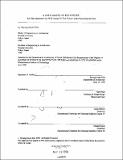| dc.contributor.advisor | Gary Hack. | en_US |
| dc.contributor.author | Kim, Myung-hwan | en_US |
| dc.contributor.other | Massachusetts Institute of Technology. Dept. of Urban Studies and Planning. | en_US |
| dc.coverage.spatial | a-ja--- n-us--- n-us-ma | en_US |
| dc.date.accessioned | 2011-12-05T19:47:55Z | |
| dc.date.available | 2011-12-05T19:47:55Z | |
| dc.date.copyright | 1990 | en_US |
| dc.date.issued | 1990 | en_US |
| dc.identifier.uri | http://hdl.handle.net/1721.1/67388 | |
| dc.description | Thesis (M.S.)--Massachusetts Institute of Technology, Dept. of Architecture; and, (M.C.P.)--Massachusetts Institute of Technology, Dept. of Urban Studies and Planning, 1990. | en_US |
| dc.description | Includes bibliographical references (leaves 151-157). | en_US |
| dc.description.abstract | Over the last quarter of a century, historic preservation has become a major component of urban revitalization in the US. Along with the cultural and economic benefits, the restoration of historic structures and environments has also produced a distinct improvement in the quality of life in several American cities. Japan, on the other hand, has only recently begun to recognize the potential contribution of historic preservation to urban revitalization; and, in general, its recent revitalization efforts, especially in several small cities, have not been well formulated or well executed. It is proposed here that small, declining Japanese cities can be revitalized, both economically and culturally, by making effective use of their historic resources. The concept of historic preservation as an urban revitalization tool is first discussed with emphasis on several major theories of preservation in an urban setting. Next, actual instances in which historic preservation was successfully integrated into urban revitalization programs are analyzed. Finally, a revitalization strategy for Otaru, a small declining city in northern Japan, is formulated based on the Urban Cultural Park concept implemented in the city of Lowell, Massachusetts. | en_US |
| dc.description.statementofresponsibility | by Myung-hwan Kim. | en_US |
| dc.format.extent | 157 leaves | en_US |
| dc.language.iso | eng | en_US |
| dc.publisher | Massachusetts Institute of Technology | en_US |
| dc.rights | M.I.T. theses are protected by
copyright. They may be viewed from this source for any purpose, but
reproduction or distribution in any format is prohibited without written
permission. See provided URL for inquiries about permission. | en_US |
| dc.rights.uri | http://dspace.mit.edu/handle/1721.1/7582 | en_US |
| dc.subject | Architecture. | en_US |
| dc.subject | Urban Studies and Planning. | en_US |
| dc.title | A past adapts to the future : an old Japanese city will adapt to the future with preserving its past | en_US |
| dc.type | Thesis | en_US |
| dc.description.degree | M.C.P. | en_US |
| dc.description.degree | M.S. | en_US |
| dc.contributor.department | Massachusetts Institute of Technology. Department of Architecture | |
| dc.contributor.department | Massachusetts Institute of Technology. Department of Urban Studies and Planning | |
| dc.identifier.oclc | 23353590 | en_US |
